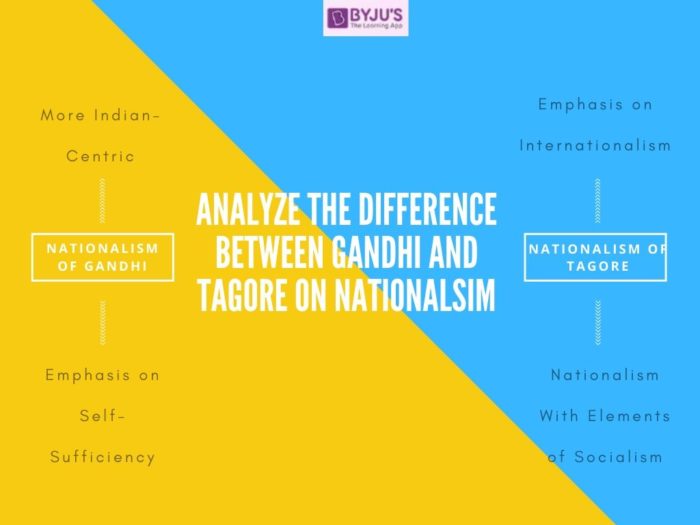The two stalwarts of the Indian Independence Struggle, Mahatma Gandhi and Rabindranath Tagore had diverging views regarding nationalism.
They both had a novel, yet different approaches when it came to defining contemporary nationalism.
Believing that imperialism is an external manifestation of nationalism, Rabindranath Tagore considered that ‘internationalism’ would cut above the narrowness of nationalism.
Mahatma Gandhi (2nd October 1869, – January 30th, 1948), on the other hand, strived to make internationalism more accepting and tolerant by broadening its horizons within the fold of nationalism.
Aspirants can find more Difference Between Articles, by visiting the linked page

This article will further highlight the differences between Gandhi and Tagore’s idea of nationalism for the IAS Exam.
Differences between Gandhi and Tagore on Nationalism
| Mahatma Gandhi wished to develop a more Indian-centric nationalism which would be far more welcoming and rooted to Indian -traditions, and cultures rather than being influenced by the west | Rabindranath Tagore (7 May 1861 – August 7, 1941) was an ardent supporter of nationalism until the outbreak of World War 1 in 1914-1918. And the war between Japan and China in 1937. |
| Mahatma Gandhi in his book “Hind-Swaraj” criticized both the moderate and extremist nationalists of the Indian National Congress as he believed that both their methods were insufficient to give a unique identity to a uniquely Indian-form of nationalism | Tagore believed that nationalism was just another term for the appropriation of wealth and territory of other countries and that it would violate the basic ideals of humanity. |
| Mahatma Gandhi argued that the type of nationalism favoured by freedom fighters everywhere was too violent in its nature and approach and it would only lead to future conflicts. | Rabindranath Tagore argued that violent nationalism would destroy civilization itself. He was also opposed to non-violent forms of nationalism such as the one represented by Mahatma Gandhi’s Non-Cooperation Movement, which he felt presented a more isolationist view of India |
| Mahatma Gandhi advocated that the role of a ‘lingua franca’ (common language between speakers whose native languages are different.) will play a crucial role in fostering nationalism in a country that has different languages and dialect groups. | Rabindranath Tagore believed that contemporary nationalism will eventually take a violent form and thus it was necessary to arrive at an alternative. |
| In conclusion, Mahatma Gandi’s idea of nationalism was to be based on self-sufficiency at all levels of society | Ultimately, as per Rabindranath Tagore, the mechanical idea of nationalism was replaced with his idea of ‘swadeshi samaj’ which was based on social relations that were not mechanical and impersonal but based on love and cooperation. Thus adding a socialist element to his belief in internationalism. |
The life and views of both Mahatma Gandhi and Rabindranath Tagore are extensively covered in the Indian history segment of the UPSC exams. Aspirant can find links below to better study this segment.:
- NCERT Ancient Indian History Notes for UPSC
- NCERT Medieval Indian History Notes for UPSC
- NCERT Modern Indian History Notes for UPSC
- Difference Between Non-Cooperation and Civil Disobedience Movement
- Difference Between Moderates and Extremists
- Important Indian Freedom Fighters and Their Contributions
- Quit India Movement
- Rise of Mahatma Gandhi during the Indian Freedom Struggle
Difference Between Gandhi and Tagore on Nationalism – Download PDF Here
Frequently Asked Questions about Mahatma Ganhi and Rabindranath Tagore on nationalism
What was Mahatma Gandhi’s concept of nationalism?
What was Rabindranath Tagore’s views on nationalism?
Become familiar with the general pattern of the IAS Exam by visiting the IAS Syllabus. For more exam-related preparation materials, refer to the links given in the table below:
Related Links
Comments